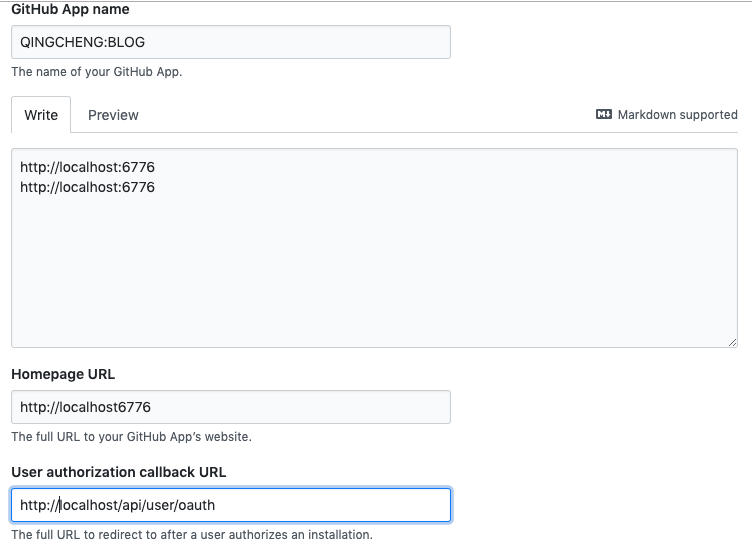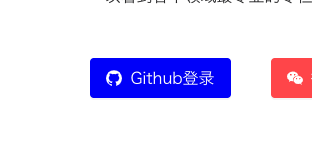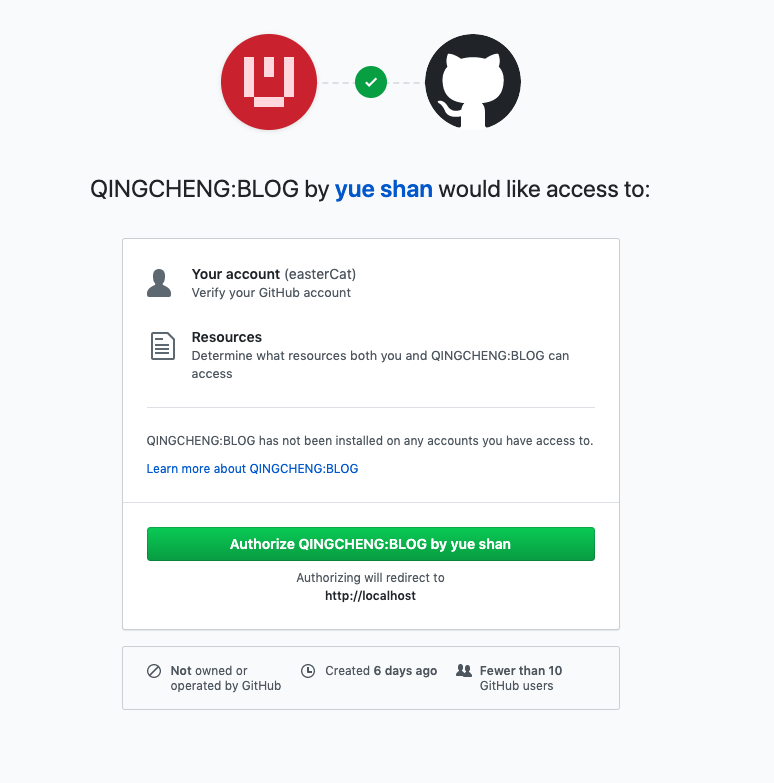[Next] Next.js+Nest.js实现GitHub第三方登录
GitHub OAuth 第三方登录
第三方登录的关键知识点就是 OAuth2.0 . 第三方登录,实质就是 OAuth 授权 . OAuth 是一个开放标准,允许用户让第三方应用访问某一个网站的资源,而不需要提供账号和密码.
总体就是:myapp <=> user <=> github
授权的总体流程
- 用户进入到我的网站,我想要获取到用户的 GitHub 信息
- 跳转到 GitHub 授权页面,然后问用户是否允许我获得他的信息,授予权限
- 同意,我的网站会获得 GitHub 发回的一个授权码,使用该授权码向 GitHub 申请一个令牌
- GitHub 授权码进行验证,没问题就会返回一个令牌(这个令牌只在短时间内有效)
- 我的网站获得令牌,然后向 GitHub 的 user 发起请求
- GitHub 验证令牌,没问题用户信息就返回过来了
- 我们通过返回的用户信息然后创建一个用户,并生成 token 返回给 client
- 然后根据 token 进行登录验证,来保持登录
授权登录一次之后就不用再次授权了,除非在 github app 中清除授权记录
应用登记
一个应用要求 OAuth 授权,必须先到对方网站登记,让对方知道是谁在请求。
所以,你要先去 GitHub 登记一下。当然,我已经登记过了,你使用我的登记信息也可以,但为了完整走一遍流程,还是建议大家自己登记。这是免费的。
user => settings => Developer settings


提交表单以后,GitHub 应该会返回客户端 ID(client ID)和客户端密钥(client secret),这就是应用的身份识别码。

webhook 通知
现在进行 oauth 应用创建的时候需要添加一个 webhook,这个就是 github 的一个通知系统,有更改的时候就会进行接口请求.现在创建 github app 强制要配置这个.

页面请求
首先在网站上加一个按钮

<Button type="primary" icon="github" size="large" onClick={this.login}>
Github登录
</Button>
//handle
public login() {
const CLIENT_ID = "Iv1.59ce080xxxxx";
const REDIRECT_URL = "ff852c46bxxxxx";
const url = "https://github.com/login/oauth/authorize?client_id=" + CLIENT_ID + `&client_secret=${REDIRECT_URL}`;
window.location.href = url;
}
点击按钮进入到授权页面

授权之后就去去请求当前应用在 github 保存的回调接口 ===> User authorization callback URL: http://localhost:6776/api/user/oauth
实现 oauth 接口
用户同意授权,GitHub 就会跳转到 User authorization callback URL 指定的跳转网址,并且带上授权码,跳转回来的 URL 就是下面的样子。
http://localhost:6776/api/user/oauth?code=df9da5bfca34bff19f2e
通过 query 拿到 code,这个就是授权码.
后端使用的是 nest.js 实现 , 之后的请求都使用后端实现.
@Get('/oauth')
@Redirect('/', 301)
async githubOauth(@Query() queryData: { code: string }) {
const ClientID = 'Iv1.59ce08xxxx';
const ClientSecret = 'ff852c46bxxxxx';
const config = {
method: 'post',
uri:
'http://github.com/login/oauth/access_token?' +
`client_id=${ClientID}&` +
`client_secret=${ClientSecret}&` +
`code=${queryData.code}`,
headers: {
'Content-Type': 'application/json',
accept: 'application/json',
},
};
const result: string = (await asyncRequest(config)) as string; //发起请求,拿到token
}
}
function asyncRequest(config) {
return new Promise((resolve, reject) => {
request(config)
.then(response => {
resolve(response);
})
.catch(error => {
reject(error);
});
});
}
拿到 token 之后我们可以通过 token 获取用户信息
const parseResult = JSON.parse(result);
const githubConfig = {
method: 'get',
uri: `https://api.github.com/user`,
headers: {
Authorization: `token ${parseResult.access_token}`,
'User-Agent': 'easterCat',
},
};
const user: string = (await asyncRequest(githubConfig)) as string; //获取用户信息
const parseUser = JSON.parse(user);
获取到用户信息{"login":"easterCat"....."created_at":"2016-07-13T07:24:06Z","updated_at":"2019-10-25T05:26:34Z"}之后,处理用户信息
我们将需要的数据创建一个新用户
await this.userService.create({
login: parseUser.login,
avatarUrl: parseUser.avatar_url,
name: parseUser.name,
createdAt: parseUser.created_at,
updatedAt: parseUser.updated_at,
}); // 创建新用户
await this.sessionService.create({
token: loginStatus,
createAt: +Date.now(),
name: parseUser.name,
}); //创建session
然后之前 get 请求下添加了跳转 redirect,此时传入跳转接口
return { url: `/logged?name=${parseUser.name}` };
验证登录
前端进行的 ajax 请求开启 withCredentials , 将 cookie 进行携带.
前端使用的使用 next.js 进行的 react 开发.后端会将页面跳转到 logged 页面.
public async componentDidMount() {
const parsed = queryString.parse(window.location.search);
const result: any = await this.props.login({ name: parsed.name });
Cookies.set("ptg-token", result.token);
this.setState({
loginStatus: true,
loading: true
});
}
当前页面进行登录接口请求,并将 token 保存到 cookie 中.

之后的持久化登录就在应用初始阶段请求后端/logged 接口,后端会从请求中的 cookie 中拿到 token,然后对 session 进行判断.

